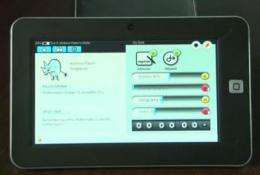Indian district plans to adopt 50,000 I-slate tablets

The U.S.- and Singapore-based creators of the I-slate educational tablet and local government officials in India's Mahabubnagar District plan to adopt 50,000 of the low-cost electronic educational slates into middle and high school classrooms throughout the district over the next three years. The plans were announced today in Hyderabad, India, by district officials, the Indian non-profit Villages for Development and Learning Foundation (ViDAL), Rice University and Nanyang Technological University (NTU) in Singapore.
The I-slate, a low-cost learning tool designed for classrooms with no electricity and too few teachers, is under joint development by the I-slate Consortium, which includes hardware and software experts at Rice and NTU, social outreach partners from ViDAL and a Los Angeles-based design team.
The district of Mahabubnagar in the Indian state Andhra Pradesh has about 500,000 students in government schools. Consortium leaders and Mahabubnagar officials said they hope to supply I-slates to at least 10 percent of the students over the next three years.
"The I-slate project is about empowering local communities with education and knowledge," said Rajeswari Pingali, ViDAL founding chairwoman. "Based on two years of lab-to-school testing rounds, today we have a fully functional I-slate which will be adapted by the district education department for expanding the footprint of technology and bringing learning opportunities backed by the latest in modern communication technology for the benefit of rural communities."
About 30 fourth-generation I-slates were delivered this month to a class of 10- to 13-year-olds at the Mohamed Hussainpalli Village School, which is located in Mahabubnagar District, about 70 miles from Hyderabad. The new I-slates are the first to feature a new "sense-optimized" user interface designed to improve educational outcomes in rural India.

"Sense optimization is a systematic way of improving the user experience by taking advantage of our knowledge of how the human brain processes the information so we can invest the minimum amount of resources for the effectiveness level we're trying to reach," said I-slate creator Krishna Palem, a professor at both Rice and NTU. "The I-slate is not a tablet computer. It is a device designed for a single purpose -- education in a low-resource environment."
Mahabubnagar is primarily rural and has a population of around 4 million. District officials plan to use the I-slate in middle and high school classrooms. With sufficient volume, the unit cost for the I-slate will be around $45 (56 Singapore dollars), Palem said.
Palem, Rice's Ken and Audrey Kennedy Professor of Computing, initially conceived the I-slate in 2008. He thought power consumption would be the biggest hurdle, because many rural schools in India lack electricity, and a solar-powered I-slate would need to run on no more than three watts of power. However, as soon as students in Mohamed Hussainpalli Village began testing early prototypes, it became obvious that usability and effectiveness would also be a challenge.
The I-slate's Los Angeles-based design team, which includes Marc Mertens, CEO of the Seso Media Group, and project leader Henrik Andersson, volunteered their time to work with ViDAL, NTU specialists in human-computer interaction and Rice student interns. The designers evaluated feedback from children at Mohamed Hussainpalli Village School and spent thousands of hours scrutinizing the placement and flow of features and the way children interacted with the I-slate both visually and by touch.
The designers incorporated elements from video games and social networking to draw students in and hold their interest. For example, a colorful cartoon creature in the corner of the I-slate screen watches the student and changes expression based upon the child's actions. The more the student studies and the better her grades, the happier the creature appears. (EDITOR'S NOTE: to see the user interface in action, watch this video.)
The I-slate is a joint project of the Rice-NTU Institute for Sustainable and Applied Infodynamics (ISAID). Palem, who directs ISAID, is a Nanyang Visiting Professor at NTU.
"It is very exciting to see the early work on the I-slate expand to a larger user base," said ISAID affiliate Vincent Mooney, associate professor of electrical and computer engineering at Georgia Tech, who worked on the I-slate as a visiting faculty member at NTU.
The hardware and graphic content for the I-slate are being developed in tandem because they will ultimately use a revolutionary low-power computer chip -- another of Palem's inventions. The new chip, which could be ready for use in the I-slate by 2013, will cut power requirements in half and allow the device to run on solar power from small panels similar to those used on handheld calculators.
Provided by Rice University


















